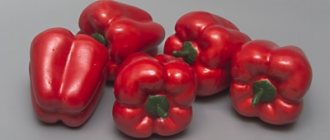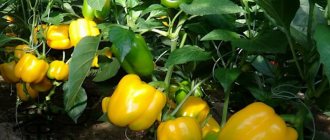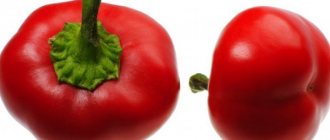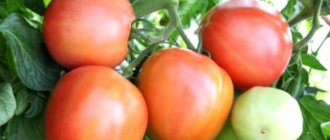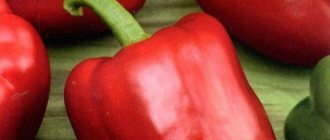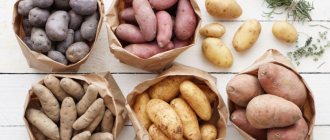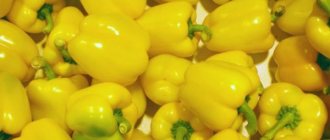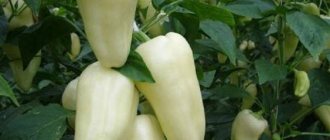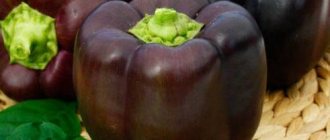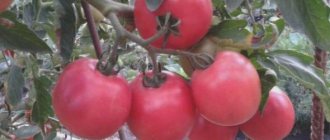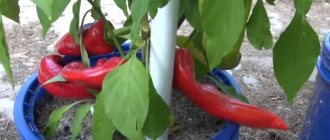General characteristics
“Yellow Bull” is a mid-season pepper. It produces a harvest around July. Productivity is high. The fruits are large, bright yellow in color. The plant is considered one of the tallest among other pepper varieties - the growth of one bush can exceed 1.5 meters. Therefore, when caring, you must tie the plant up.
In general, the “Yellow Bull” is unpretentious and is not afraid of disease. The variety has good taste and grows well in any agrotechnical conditions. Only occasionally requires feeding.
Characteristics and description
Description of the bush
May be interesting Potato “Breeze” - description and characteristics How to feed peppers with iodine: features and application rules Cucumber Meringue f1: description and characteristics, reviews
We can immediately say that the sweet pepper “Yellow Bull F1” is large-fruited. Such hybrids often have very powerful, spreading bushes. To get a good harvest, you should take care of enough space. The tall stem has many rich green leaves. But growing has its own subtleties that apply specifically to bushes:
- Before forking, you should always remove leaves as they grow;
- a garter is required;
- It is customary to remove the first bud;
- bushes should receive a lot of light;
- The root system is powerful, but many branches are located close to the surface, so you need to be careful when loosening.
Advice!
Most often, summer residents make a trellis that will serve for many years, because they return to this hybrid year after year.
Features of care
Pepper does not require complex agrotechnical care. For its proper growth, it is enough to carry out a set of standard actions:
- watering (the plant is not afraid of cold water, but it is better to feed it with liquid at room temperature);
- fertilizer (every three weeks, preferred substances are phosphorus and potassium);
- pruning (lower leaves and twigs without peppers should be removed so that they do not take away nutrients).
You can keep peppers in a greenhouse, under an awning or in a greenhouse. It grows more slowly in the open air, but still bears fruit (albeit half as much).
Since the main goal of most vegetable growers is to produce large fruits, additional care measures should include removing weeds from the ground near the plant.
Interesting. “Yellow Bull” is one of the few varieties that can grow in central Russia in open ground without any shelter. However, it is worth considering that excessive coolness inhibits fruit growth and flower setting.
Due to its large growth, the bush may break. To prevent this from happening, even when planting, the seedlings need to be tied to a trellis. If not, wooden supports will do.
Features of the view
Pepper Yellow Bull is a hybrid that was bred by domestic breeders. It was obtained by crossing two varieties. There is no point in collecting seeds from grown fruits.
The yellow bull is thermophilic. It is not recommended to grow it without shelter in the risky farming zone. It was developed for central and southern Russia. Although, as practice shows, summer residents manage to achieve good results if they plant peppers in greenhouses.
The hybrid is classified as mid-early. Peppers can be harvested after 125 days of vegetative development. If you pick, apply fertilizers in a timely manner and create favorable conditions, the harvest will appear after 110 days.
Description of the Yellow Bull pepper hybrid:
- bushes are vigorous, they reach 1.5 m in height;
- the foliage is lush, dark green;
- fruiting is long-term: ovaries are formed from June-July until cold weather;
- yield per 1 m2 varies from 7-9 kg to 20 kg depending on growing conditions;
- pepper can be stored for a long time and transported, this does not affect its presentation.
Important!
Manufacturers note that when breeding the Yellow Bull hybrid, it was made genetically resistant to many viral diseases of pepper (tobacco mosaic, potato virus). Yellow Ox pepper bushes must be tied up, otherwise the branches begin to break under the weight of large fruits. It is best to use a trellis; each branch is tied separately. For tall varieties and hybrids, it is recommended to leave 3 main shoots.
Growing in Russia
Pepper can be planted in those regions of the country where in summer the air temperature reaches at least 15 degrees and daylight hours are at least 12 hours. If your region does not meet these requirements, you will have to use one of the additional measures:
- build an awning to cover the plant at night to protect it from cold weather4
- install lamps near the bushes;
- place the plant in a greenhouse or greenhouse.
In any region of the country, pepper will develop well in a greenhouse, and the only thing it may need besides thermal air is ultraviolet lamps if it is constantly cloudy outside.
The soil of central Russia is suitable for planting seedlings. To make the bushes develop faster, it is recommended to add a little sand and organic fertilizers to the clay soil. In some regions where the soil is already sandy-clayey, this measure is not required.
Russian agricultural farmers, by properly caring for the plant, receive a large harvest - up to 20 kg per square meter.
Resistance to diseases and viruses
The main advantage of pepper is its excellent resistance at the genetic level to the tobacco mosaic virus. This is very important because scientists have not yet developed antiviral drugs. This virus, infecting the leaves, destroys chlorophyll in the cells, and this can lead to the death of the entire plant in a matter of days. Find out more about sweet pepper diseases.
Disembarkation dates and rules
The vegetative cycle of the plant is about 110 days. The plant will produce fruits 3-4 months after planting. You need to sow peppers at home in early February. Then, after allowing the seedlings to grow, move them into open ground.
At home, you need to place 1-2 seeds in one pot, provide the sprouts with constant care and a temperature of about 24 degrees. When the plants get stronger, they can be planted after feeding them first. The optimal time for planting is March.
When planting, you need to correctly calculate the density of the bushes. There should not be more than 4 bushes on one square meter of soil. Even this number of plants will be enough to produce tens of kilograms of harvest.
This volume is enough for the entire autumn period for the average family.
Features of cultivation
You can get large fruits and excellent yields if you follow the growing rules.
Seeds are sent to seedling boxes in late February - early March after pre-sowing preparation. Considering that the germination rate of the seeds of this hybrid is on average 92%, they can first be soaked for 20 minutes in a solution of potassium permanganate, and after washing - in aloe juice. Thanks to this procedure, the seeds are disinfected and become stronger. Some people use growth stimulants for soaking.
This will shorten the period of vegetative development until the fruit ripens by 1-2 weeks.
During the growing period, seedlings must be fed with root formation stimulants and complex fertilizers. It is important to harden off young plants so that they can tolerate transplantation into open ground more easily and are not afraid of sudden cold snaps. To do this, pots with plants are taken outside, and the time spent outdoors gradually increases. It cannot be assumed that the temperature was below 13 o C.
At two months of age, Yellow Bull seedlings are planted in the ground. The period is counted from the date of emergence of seedlings. When planting Yellow Bull in the main growing area, the optimal planting pattern is 50x40.
It is advisable that no nightshade crops grow at the site of the planned planting for 2 years: eggplants, potatoes, tomatoes.
But you should also focus on the appearance of the plants. Each seedling bush should have 8-12 leaves. The optimal time for planting is the period when the first buds begin to form. The air temperature should be at least 15-17 o C, and the soil in the planting hole should be 10-12 o C.
In order not to interfere with the formation of fruits, excess shoots must be removed. All side shoots and lower leaves that grow before the first branching of the stem are removed. If the plants are planted in open ground, then it is necessary to provide supports to which the shoots will be attached. In greenhouses they are tied to trellises.
Harvest Features
The fruits of the “Yellow Ox” are considered one of the largest. They reach a length of more than 20 cm. The shape of the pepper is cone-shaped. The stalk is deeply recessed into the top of the pepper. The radius of the fruit is up to 4 cm. The wall thickness is a record for Russian varieties, about 10 mm.
Farmers begin harvesting in July. You can pick the fruits for testing at the end of June, but then some of the peppers are not yet ripened. Technical maturity of the fruit occurs when it acquires a rich golden hue. If you remove the pepper from the bush a little earlier and leave it to ripen, the color of the skin will not change.
You may be interested in: Favorable days for planting pepper for seedlings in 2021: terms and rules for sowing at home Favorable days for picking pepper in 2021 according to the lunar calendar Favorable days for sowing sweet and bitter pepper for seedlings in 2021
The fruits retain their presentation for a long time and are difficult to damage during transportation. When transported correctly, the walls do not burst or crack, and dents and darkening do not appear on them. Due to the fact that the plant is genetically protected from diseases, there are no contrasting spots on the surface of the peppers that would spoil the appearance of the product.
Important. Yield characteristics will decrease significantly if bushes are grown in the northern regions of the country. If sudden cold snaps occur and cold rains begin, use Nutrasil to cover the bushes so as not to reduce the harvest.
When grown in open ground, one square meter of soil produces up to 9 kg of fruit. If you plant seedlings in a greenhouse or greenhouse, the harvest volume can reach 20 kg.
The weight of one fruit is generally in the range of 200-250 grams. However, with constant feeding and growing in warm conditions, it can reach up to 400 g.
If you start harvesting in July and continue to feed the plant, it will continue to bloom. Then the harvest can be gradually obtained until the onset of cold weather. With a sharp drop in temperature, the crop does not die, but stops growing, fruiting, and flowering.
There is no need to pollinate the plant. The establishment occurs by the mechanism of self-pollination.
Taste and external qualities of pepper
"Yellow Bull" is a hybrid. It was obtained by domestic breeders by crossing two varieties of pepper. The “calling card” of the variety is considered to be a huge fruit: the length of the vegetable reaches 20 cm, in cross section the diameter is 8 cm. The pulp of the “Yellow Bull” is very thick - 10 mm. The average weight of a vegetable varies from 200 to 250 g. Particularly large fruits can weigh up to 400 g. Their skin is thin, tender, and the surface is glossy. The vegetable has the shape of a truncated cone, with three to four clearly defined edges and a depressed stalk. During the growth period, the fruits are colored green, and upon reaching technical ripeness their color becomes golden yellow.
The taste of the vegetable is excellent: the thick flesh is exceptionally tender, juicy, and sweet. The amazing fresh aroma of pepper will surely be remembered by everyone who has tried it at least once. The purpose of the fruit is universal. It is consumed fresh, canned, and used to create culinary masterpieces.
Important! Pepper of the “Yellow Bull” variety can be stored for a long period of time without loss of juiciness, taste and commercial qualities.
Application of "Yellow Bull"
The main purpose of the culture is to be used for culinary purposes. Farmers buy seeds and grow the fruits during the summer, trying to get the maximum harvest, and cooks buy the fruits of the “Yellow Ox” and prepare various dishes:
- lecho;
- canned vegetables;
- vegetable salads;
- stuffed dishes;
- grilled vegetables.
The fruits have excellent taste: they are not watery and do not leave a bitter aftertaste. The walls of the fruit are crispy, the peel is thin and makes it easy to bite into the chopped vegetable. Dishes made from fresh pepper are recommended to be consumed in hot weather, when the body constantly requires a supply of fluid.
Canned and stuffed peppers are good in winter. They allow you to saturate the body with vitamins and reduce the risk of vitamin deficiency.
For reference. Yellow pepper varieties are the most attractive to buyers. If your goal is to make as much profit as possible, when choosing between “Yellow Bull” and red varieties, preference should be given to the first option.
Even inexperienced vegetable growers can purchase the crop, because it does not require careful care and expensive fertilizers. At minimal cost, the plant produces a large harvest.
Advantages and disadvantages of the variety
People who have purchased the domestic variety speak mostly positively about it. Reviews can be found below. However, the “Yellow Bull” can have not only advantages, but also disadvantages.
Positive aspects of the variety:
- Big harvest. When planted tightly, you can get more than ten kilograms of fruit.
- High quality fruits. Peppers taste good, do not spoil during storage, and have an excellent presentation.
- The versatility of the fruit. Peppers can be salted, stuffed, eaten fresh or frozen.
- Good payback of the variety. Peppers sell quickly, and the vegetable grower can easily cover the minor costs of purchasing seeds and cultivating the soil.
- Does not require any chemical treatment, since it is genetically protected from diseases. In this regard, it is safe for children and allergy sufferers, as well as animals that live on the site and can eat the treated leaves. Also, the absence of pesticides allows for significant savings on crop maintenance.
A small number of disadvantages:
- When grown in open ground, the yield is 2 times less.
- The plant needs to be tied up, and it is advisable to purchase a strong trellis (which will cost several thousand).
Due to the fact that this crop is a hybrid, growing a plant from your own seeds is complicated. Planted seeds may not sprout at all. Therefore, vegetable growers who are constantly growing “Yellow Bull” have additional expenses for purchasing a new batch of seeds. However, these costs quickly pay off.
The disadvantage can be considered insignificant for private vegetable growers, but for large farmers it can become a serious obstacle.
Fruit characteristics
When growing pepper in the southern regions in unprotected soil or in greenhouses, greenhouses in other climate zones, gardeners begin to harvest the crop in July. Peppers reach technical maturity 1-2 weeks earlier.
Manufacturers indicate that the Yellow Bull has the following appearance:
- length of peppers 20 cm;
- fruit diameter 8-9 cm;
- tender pulp 10 mm thick;
- average weight 200-250 g, farmers, subject to cultivation techniques, receive fruits weighing up to 400 g;
- the surface is covered with delicate thin skin, glossy;
- the color is golden-yellow when ripe, at the stage of technical maturity – green;
- the shape of the peppers resembles a truncated cone;
- the stalk is depressed;
- the fruits are divided into 3-4 lobes.
Yellow ox has a sweetish taste and has a pronounced peppery aroma.
Many farmers note in their reviews of the Yellow Bull that the peppers are even larger than the manufacturers claim. Practice shows that if you collect fruits at the stage of technical maturity, the yield is almost 1.5 times higher. This is due to the fact that old fruits do not draw juices from the plant when ripening, and the plant’s energy is not wasted on the formation of seeds.
The purpose of pepper is universal. It is suitable for preparing salads, eating fresh, canning, and pickling.
Reviews from vegetable growers
Galina V., 47 years old, Kaluga region: “The variety grows well and quickly, with almost no fertilizers. To plant it, you do not need to completely dig up the soil; just add a nutrient solution and a little sand. The bushes bear fruit well even in dry years.”
Gennady K., 53 years old, Leningrad region: “I have been growing “Yellow Bull” on my own farm for more than two years. The harvest is always good, but sometimes it is difficult to determine the ripeness of the fruits - they ripen unevenly. I believe that breeders can still work on this hybrid.”
Ekaterina M, 33 years old, Moscow region: “I’ve been growing “Yellow Bull” on my plot for the second year, both times the harvest was good and plentiful. There were almost no problems with the plant, only once after a strong thunderstorm some bushes broke. The variety is perfect for me, as a beginner in vegetable growing.”
When purchasing a variety, you need to pay attention to the company that distributes the seeds. Some subspecies of “Yellow Ox” may be slightly smaller or produce a smaller yield, so you should purchase grains only from trusted agrotechnical companies.
